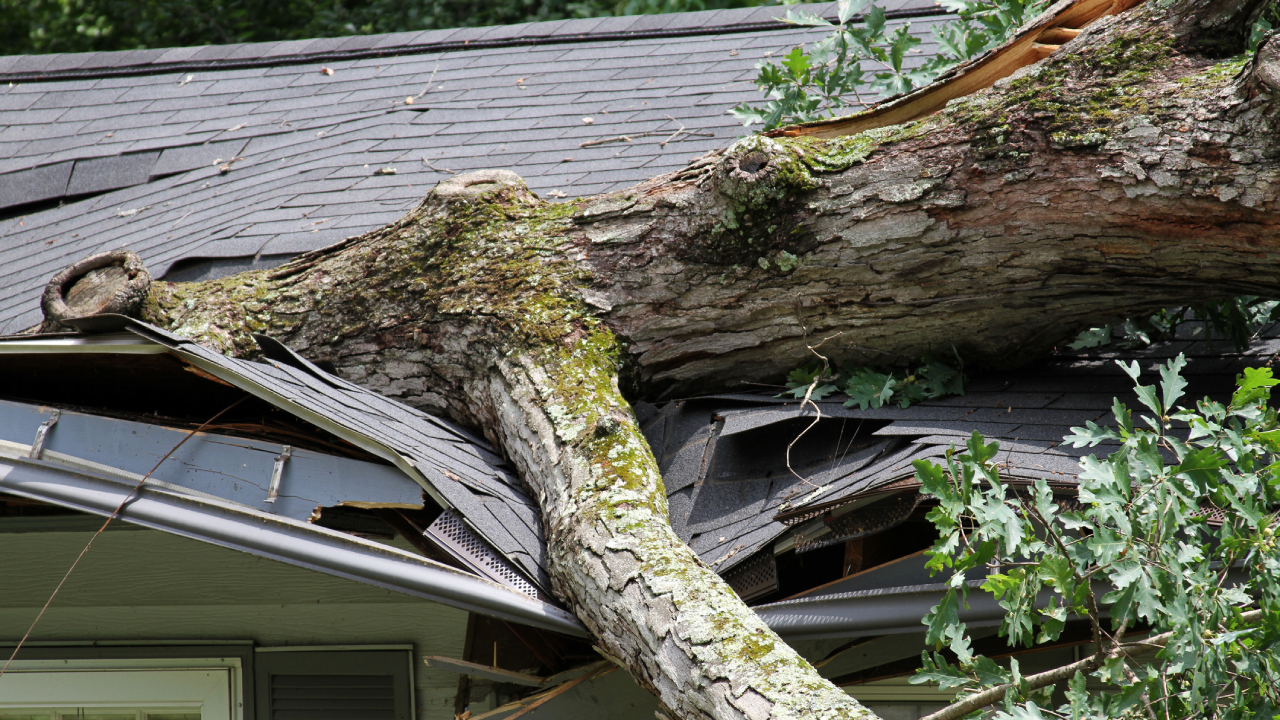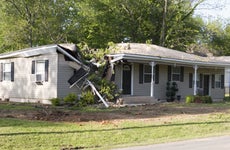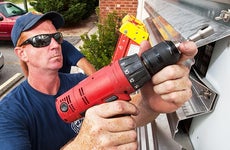Restoring stability: home insurance as a safety net for financial stress during disasters

The Bankrate promise
At Bankrate, we strive to help you make smarter financial decisions. To help readers understand how insurance affects their finances, we have licensed insurance professionals on staff who have spent a combined 47 years in the auto, home and life insurance industries. While we adhere to strict , this post may contain references to products from our partners. Here's an explanation of . Our content is backed by Coverage.com, LLC, a licensed entity (NPN: 19966249). For more information, please see our .
As of early April 2024, there have already been two weather-related events that have caused upward of $1 billion in damage, according to the National Oceanic and Atmospheric Administration (NOAA). While two may seem like a low number, the NOAA predicts that this won’t be a mild year for natural disasters. From 1980 to 2023, the average number of billion-dollar climate disasters was over eight events per year. When you zoom in to focus on the five-year period from 2019 to 2023, the average jumps up to over 20 per year. As the frequency and severity of these events continue to rise, it’s critical to be prepared. While having a home insurance policy that covers the risk of natural disasters won’t prevent them from happening, it can provide you with financial protection and act as a valuable safety net in the event of a natural disaster.
Financial impact of natural disasters data and statistics
- Within the past 10 years, 20 percent of Americans have incurred home or property damage expenses due to extreme weather events.
- 23 percent of Americans report experiencing costs related to spoiled food because of extreme weather in the last decade.
- 57 percent of Americans believe that extreme weather events will have a negative impact on their personal finances over the next 10 years.
- Over the past decade, more than 63 percent of Southerners say they have incurred costs due to extreme weather events.
Key takeaways
- Natural disasters, depending on the frequency and your location, can have significant financial implications.
- It is important to keep proper records and documentation of any impacts from extreme weather to file a successful insurance claim.
- There are other options for disaster relief such as FEMA funding, but having effective insurance is one great way to be financially prepared for a disaster.
Using home insurance for disaster assistance
“The U.S. experienced 28 separate billion-dollar weather and climate events in 2023, and $60 billion in severe convective storm losses, both record levels. This is why it is so important to make sure you are financially protected from devastating property losses with the right types and amounts of home insurance coverage,” says Mark Friedlander, director of corporate communications for the insurance information institute (Triple-I).
In speaking with Bankrate, Friedlander also mentioned that the cost of construction materials and labor cumulatively increased by 55 percent and is nearly four times the Consumer Price Index, which can affect your home’s replacement cost. To ensure that your policy accounts for inflation, insurance experts recommend doing an annual review of your home policy with a licensed insurance agent.
When discussing home insurance and natural disasters, Friedlander stressed the importance of not neglecting flood insurance.
As 90 percent of U.S. natural disasters involve flooding, it’s also important to consider adding flood insurance to your financial protection package. Lack of flood coverage is the largest insurance gap we see today as only 4 percent of homeowners have a flood policy. Last year, we experienced floods across all regions of the country, even in the California desert during mid-summer. No area of the U.S. is immune to flooding. It’s not just a coastal issue during hurricane season.— Mark Friedlander, Triple-I
Friedlander goes on to say, “We strongly recommend homeowners conduct an annual review of their insurance coverage with their agent to ensure they have the right amounts and types of property insurance, close any gaps, and take steps to prevent a catastrophic financial loss from the wrath of Mother Nature.”
If you experience a loss that is covered by your home insurance policy, you can submit a claim, and you’ll be reimbursed up to your policy limits. In most cases, insurance will cover home improvements after a disaster — at least in part, assuming you have appropriate coverage.
You may wonder if after a home disaster you can just keep the insurance money and not rebuild. Generally, claim checks are required to be used toward their intended purpose of repairs or rebuilding, and not doing so could cause issues with future claims being approved. However, you may be able to keep leftover funds if the costs end up being less than what your insurer issued. If you are still paying a mortgage, your lender will likely be included as a co-payee on the check to protect their financial investment.
Filing a claim after a natural disaster
Depending on the extent of damage you experience after a natural disaster, you may not decide to file a claim. Because filing claims usually leads to increased premiums based on risk, you may choose to repair the damage out of pocket, especially if the cost of repairs are close to your deductible. If you avoid filing a claim, your premium should be unaffected. However, if you have still not made necessary repairs out of pocket by renewal time, your home may still be viewed as high risk by your insurer, potentially causing a premium increase.
Home insurance policies can help pay for damages that are covered under your policy. However, after large natural disasters, claims may take longer to be paid out due to heightened demand. If your home repairs aren’t completely covered by standard home insurance, there are several ways you could get financing for disaster relief.
Flood insurance
Flood insurance typically isn’t included under a standard home insurance policy, so if you live in a flood-prone area, you may want to purchase a separate flood insurance policy. Flood damage can cost up to $7.50 per square foot to repair, so having flood insurance could pay off after a natural disaster.
Flood insurance typically covers the structure of your home, built-in appliances, attached structures, clothing, home decor, and personal belongings up to your policy limits.
Other extended policies
Depending on where you live, you may want to consider policy endorsements that provide coverage for a variety of disasters.
- Wildfire coverage: Some home insurance policies include coverage for wildfires, but others require you to purchase additional coverage
- Earthquake coverage: If you live in an earthquake zone, you may want to purchase this endorsement, since it’s typically excluded from home insurance policies.
- Windstorm coverage: Most wind damage is covered by standard home insurance policies. However, in some parts of the country, you’re more likely to have to purchase a windstorm endorsement.
Other ways to get financing for disaster assistance
If you need additional assistance paying for home repairs after a disaster, you may want to look into the following options.
- U.S. SBA loans: SBA loans are backed by the federal government and can be used for remodeling and home improvement.
- FEMA programs: FEMA offers home repair and home replacement services to individuals with unlivable or damaged homes following a disaster.
- Personal loan: Personal loans are typically easy to apply for from banks, credit unions or virtual lenders. Often, you can apply for a loan and have the funds available the next day. You just need to show proof of income and employment, proving that you have good job history and can repay the loan.
- Home equity loan: Home equity loans are typically available in larger sums than personal loans since they are secured against the equity you have in your home.
- Crowdfunding: If you need help paying for damages following a disaster, you could seek financial support from friends, family and others who want to contribute to your efforts. Platforms like GoFundMe are often used to fundraise disaster relief for organizations and individuals.
Average cost of popular home repairs needed because of disasters
| Home repair type | Cause of disaster | Average cost of repair |
|---|---|---|
| Minor fire and smoke damage | Wildfires | $2,500- $5,000 |
| Major fire and smoke damage | Wildfires | Around $50,000 |
| Siding damage | Heavy winds, cyclones, hurricanes | $354-$1,445 |
| Flooding and water damage | Heavy rains | $1,347-$6,094 |
| Window damage | Heavy winds, wildfires, cyclones, hurricanes | $180-$409 per window |
| Sidewalk or patio damage | Heavy winds, wildfires, cyclones, hurricanes | $2 to $25 per square foot |
| Roof damage | Heavy winds, winter storm, wildfires, cyclones, hurricanes | $379-$1,755 |
| Frozen pipes | Winter storm | $119 per hour for a plumber |
Note that the cost of repairing each issue differs based on severity of the damage and the type of materials needed. For instance, light flooding could be fixed with a shop vac and airing out the place, while severe flooding could require a full remodel.
Frequently asked questions
-
-
A natural disaster is a type of severe weather with the potential to pose a serious threat to human health and safety, property or infrastructure.
-
Home insurance can protect your finances. However, to protect your home and possessions, you may want to reinforce doors and windows, use sandbags to divert water, secure outdoor furniture, prune large trees, secure heavy furniture to your walls, look for fire-retardant plants and create an emergency plan.
-
It may surprise you to know that cyclones are actually the most financially costly natural disaster type in the U.S. According to the National Centers for Environmental Information, the U.S. has experienced 61 tropical cyclones since 1980, causing a combined $1.3 trillion in total damages. The most expensive cyclone that hit the U.S. was Hurricane Katrina, which caused more than $197 billion in damage.
-
It is becoming increasingly common for insurance providers to choose to nonrenew insurance policies for properties deemed to be in a disaster-prone area. It is legal for an insurance provider to drop your coverage based on the risk factors associated with your property’s location, as long as it provides the required upfront notice in accordance with state law. Check your policy to see what conditions allow your insurance provider to cancel your coverage and check for any laws within your state that may protect you from losing coverage.
If your coverage is dropped, shop around and compare policies from home insurance providers offering coverage in your area.
-
Related Articles

Shopping for home insurance? Waiting until you move may cost you money


